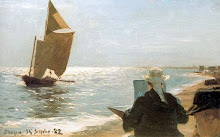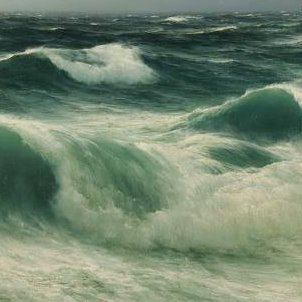Recently I was looking at the website of the artist/illustrator Kinuko Y Craft, who likes to work on a small scale with very fine detail (often using 00 size brushes). She mentioned that she uses Claybord pre-prepared panels as her support. Made by Ampersand, they have a very smooth surface, making them suitable for miniatures and fine work. The clay provides an absorbent surface that takes paint well.
If your aim is to produce a hyper-real image, you don't want a textured support that draws attention to to the surface and destroys the illusion of depth. But for plein air work, surface textures such as the brush marks of un-sanded priming, can add interest, energy, and a kind of honesty.
To get this level of smoothness with home-prepared supports would take a lot of sanding of multiple coats of primer or gesso, waiting for each coat to dry. Some might find the surface too smooth for their style of painting. I have yet to try them myself. Would welcome comments from those who have.
The panels, which are supposedly more archival than masonite, are also made with a box-like cradle suitable for hanging unframed (you might have to clean up the edges for presentability if you are a messy painter). The sides are also paintable. They are not cheap, but if you don't want to spend time preparing panels, they might be a good option, and you can save on framing costs if you use the deep cradled panels and hang them unframed for a clean, modern look.
The thin un-boxed panels would be the most convenient for plein air trips. Plein air painters often use slotted boxes to separate wet panels during transportation.



































4 comments:
Lovely blog - thank you for the nice words about our Claybord. I will contact the artist to see if they are interested in being featured in our online gallery :).
Andrea Pramuk, Ampersand Art Supply
FYI, I have been using clayboard now for several years on my abstract oils and sometimes for smaller romantic landscapes. I also use linen canvas for pieces larger than what clayboard would support. I've found clayboard to be a wonderful substrate to work on primarily because of the amazingly smooth surface. I have developed a technique (secrete) which in combination with the smooth surface, often leads my work to be confused with an abstract photographic image.
I will say something that one should know if they are going to work on clayboard with oils. My initial experiences were not very positive because clayboard is a very absorbent surface and any oil I applied to the surface was quickly soaked in leaving the pigment on the surface with little binder to hold it together. I learned to seal the surface before painting. I do this by applying two coats of Galkyd (from Gamblin) with drying time in between. This allows me to paint on the surface and have the paint remain intact. I'm sure that there are several mediums that could be used to seal the surface. I just prefer Galkyd.
I certainly would encourage anyone to try clayboard. You can see my work at my website http://www.roijames.com
Roi James
Hi Roi. Thanks so much for the tip about sealing the claybords. I'll try that if I have problems with too much absorption. I've bought a few claybords and am looking forward to working on a really smooth support as most my paintings are quite small, and I find the weave of canvas too textured to work on at that scale, without a lot of preparation of the surface with gesso and sanding.
Another option for a smooth surface is to paint on lightly sanded metal sheet, or primed paper mounted on board.
Just checked out your website Roi. Amazing and beautiful work. I was really blown away. Would I be able to post your seascape entitled "Anna's Ocean" on this blog with a link to your website of course?
Post a Comment